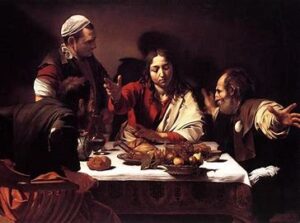By Rev’d Canon Ian Morter
Like many others, I enjoy both giving hospitality in my home and receiving hospitality from others. It is one of the fundamental joys of life, sharing food and conviviality with family and friends. There is the joy of planning a meal that will hopefully be enjoyed by all, as well as the occasional unexpected meal shared quite spontaneously.
As we keep the Third Sunday of Easter this weekend we hear of the Resurrection appearance in Emmaus recorded in St Luke’s Gospel Chapter 23. This is one of a number of accounts throughout the Gospels when Jesus shares the hospitality of friends. This particular meal is in the Village of Emmaus, some seven miles from Jerusalem and it is the evening of the day of Jesus’ Resurrection. Jesus becomes the guest at the home of two of his disciples, Cleopas and his companion but although they had spent the journey walking from Jerusalem to Emmaus talking with Jesus they did not recognise him until they had supper with him. But we will return to the Resurrection appearance later. Let me introduce you to the painting.

Supper at Emmaus was painted in 1601 by the artist Caravaggio when he was thirty years old. In fact his name was Michelangelo Merisi, Caravaggio was the town where he was brought up near the city of Bergamo. In about 1592 at the age of 21 he moved to Rome and it was here that he made his name. He came to the attention of Cardinal Del Monte who commissioned him to paint a number of character portraits, perhaps the best known is that of Bacchus now in the Uffizi in Florence. It was most probably through his Cardinal patron that Caravaggio received a commissions to paint large scale religious works for the French Church of St. Luigi in Rome, The Call of St Matthew in 1599. And subsequently, The Martyrdom of St Matthew in 1600 and St Matthew and the Angel in 1602. In these paintings Caravaggio dramatically changed his style from clear bright painting of his portraits to scenes that contrasted light and shadow ‘chiaroscuro’ as it is called in the art world. This chiaroscuro style became Caravaggio’s signature for the remainder of career. He was much in demand in Rome but had to flee as he killed someone in an argument in 1606 and spent the remaining four years of his life moving from Naples, Malta, Sicily continuing his many paintings in each city. On returning to Naples he died from fever at the age of 39.
I have known the painting Supper at Emmaus for many decades as it is one of the treasures of the National Gallery in London which I visit regularly. The painting is a snapshot of the moment when Jesus reveals himself to the two disciples with whom he had travelled from Jerusalem on the afternoon of his Resurrection. But Jesus was not recognised by his travelling companions yet during the journey Jesus had spoken to them of the scriptures that foretold of the suffering servant of God and his predicted glory. As they approach the Village of Emmaus Jesus seemed to signal he was continuing his journey but compelled by the disciples hospitality he joins them for supper. It was as he took the bread and blessed it that the two disciples recognised Jesus. He then disappeared from their sight. They returned then and there to Jerusalem to tell the gathered disciples that they had met the risen Lord and recognised him in the breaking of bread. You can see in the painting the surprise of the disciples, on the right with outstretched arms which give a wonderful sense of perspective, the other disciple is caught in the movement of rising from his seat. The third figure of the servant is in the increasing shadow and is almost oblivious to the momentous event of this Resurrection appearance.
The gift of hospitality was rewarded for Cleopas and his companion by the Resurrection appearance of their risen Lord. Our own experiences of hospitality may not be as dramatic as that in Emmaus but will usually be rewarding is so many other ways.